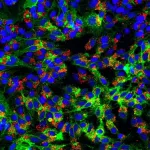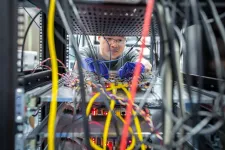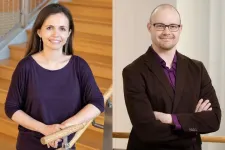(Press-News.org) Researchers at Princeton have determined how five cellular proteins contribute to an essential step in the life cycle of hepatitis B virus (HBV). The article describing these findings appeared March 11, 2021 in the journal Nature Communications.
Viruses have been with us, shaping our lives, societies and economies for millennia. While some viruses rapidly explode onto the world stage, others smolder in our communities for decades, shattering lives but making few headlines. Hepatitis B virus hasn't caused any nationwide lockdowns or stock market crashes because it is slow to spread from person to person and is rarely immediately fatal. It is nonetheless incredibly damaging because it can establish lifelong chronic infection with profound consequences for its victims.
"An estimated two billion people have been exposed to HBV, of whom 250-400 million are chronically infected," said Alexander Ploss, associate professor of molecular biology at Princeton University, and senior author on the study. "Currently, there is no cure for chronic HBV infection, and patients need to be on a lifelong antiviral regimen. Approximately 887,000 individuals die each year from HBV-related liver diseases or liver cancer."
Ploss and his team are striving to understand HBV's life cycle in hopes of finding a way to prevent the virus from establishing damaging chronic infections.
"Central to HBV replication is the formation of covalently closed circular DNA (cccDNA) from relaxed circular DNA (rcDNA) which is carried into the host cell by the virus during the initial infection," Ploss said. "We have recently demonstrated that HBV relies on five host proteins - namely PCNA, RFC complex, POLδ, FEN-1, and LIG1 - that are necessary and sufficient for this conversion step."
As its name implies, rcDNA is a loop of DNA. DNA is a molecule made up of nucleotides arranged in linear fashion along paired, complementary strands. The sequence of nucleotides on one strand encodes the instructions for making a protein while the other strand is its mirror image. Whereas human cellular DNA contains over 20,000 genes, HBV's DNA genome only contains four. None of the viral proteins made from these genes is required for the conversion of rcDNA to cccDNA. Instead, the virus coopts cellular proteins to accomplish this and other steps of viral replication.
A key feature of HBV rcDNA is that each of its two strands contains a gap in its nucleotide sequence. One strand, called the plus strand, has a gap that is considerably larger than and offset from the gap on the other, minus strand. Cells perceive gaps in DNA as damage that needs to be filled in and repaired. The cellular proteins that carry out DNA repair can't tell the difference between viral DNA and cellular DNA, so they set to work "repairing" rcDNA as soon as it arrives in the nucleus. This repair process converts rcDNA into an intact circle of double-stranded DNA (that is, cccDNA) that can be maintained in the cell's nucleus.
Postdoctoral fellow Lei Wei wanted to understand how this repair process takes place in detail. To investigate this, he developed a method to monitor the process of repair taking place on rcDNA. He then identified what steps are involved in repair of each individual strand, tracked the order in which they are completed, and determined which cellular proteins are needed for each step.
The experiments showed that conversion of the plus strand into a continuous circle happens rapidly and requires all five of the cellular proteins working in concert. In contrast, repair of the minus strand requires only two of the five proteins (FEN-1 and LIG1) but is slower because there is a viral protein attached to one end of the minus strand that must be removed before the nucleotide gap can be sealed.
"In this paper, Wei and Ploss provide a compelling story in elucidating the cellular machinery that is essential for converting the incoming HBV genome into the cccDNA," said Dr. T. Jake Liang, a National Institutes of Health Distinguished Investigator in the Liver Diseases Branch who is an expert on HBV and related viruses. "This work offers not only important insights into the biochemical pathway of cccDNA biogenesis but also potential strategies to target cccDNA for therapeutic development."
Furthering that goal, the Princeton researchers showed that two compounds targeting cellular proteins could disrupt rcDNA conversion to cccDNA in test tubes. Wei and Ploss are hopeful that future studies will identify drugs that work in the human body.
"Our findings, biochemical approaches, and the novel reagents that we generated and engineered, open the door to providing an in depth understanding how this major human virus establishes persistence in host cells," Ploss said.
INFORMATION:
This work was supported in part by grants from the National Institutes of Health, the American Cancer Society, the Burroughs Wellcome Fund, the New Jersey Commission on Cancer Research, and Princeton University.
RESEARCH TRIANGLE PARK, N.C. -- New Army-funded research could help lay the groundwork for future quantum communication networks and large-scale quantum computers.
Researchers sent entangled qubit states through a communication cable linking one quantum network node to a second node.
Scientists at the Pritzker School of Molecular Engineering at the University of Chicago, funded and managed by the U.S. Army Combat Capability Development, known as DEVCOM, Army Research Laboratory's Center for Distributed Quantum Information, also amplified an entangled state via the same cable first by using the cable to entangle two qubits in each of two nodes, then entangling these qubits further with other qubits in the nodes. The peer-reviewed journal ...
Atherosclerosis is the underlying condition that causes heart attacks and strokes. Researchers at Radboudumc in the Netherlands have discovered a protein that appears to play an important role in atherosclerosis. The protein is called Prosaposin, and its role in atherosclerosis was sofar unknown. "We identified Prosaposin as a new potential target for the Science Translational Medicine.
Atherosclerosis is caused by cholesterol that builds up in the vessel wall and triggers chronic inflammation. It has been well established that cholesterol lowering drugs help to treat atherosclerosis. Recent research has shown that inhibiting inflammation can also help to prevent heart attacks and ...
What The Study Did: In this phase 1 study, a single immunization with Ad26.COV2.S (Janssen/Johnson & Johnson) vaccine induced rapid binding and neutralization antibody responses as well as cellular immune responses. Two phase 3 clinical trials are currently underway to determine the efficacy of the Ad26.COV2.S vaccine.
Authors: Dan H. Barouch, M.D., Ph.D., of Beth Israel Deaconess Medical Center in Boston, is the corresponding author.
To access the embargoed study: Visit our For The Media website at this link https://media.jamanetwork.com/
(doi:10.1001/jama.2021.3645)
Editor's Note: Please see the article ...
Does a warmer climate mean more dry land? For years, researchers projected that drylands -- including deserts, savannas and shrublands -- will expand as the planet warms, but new research from the Harvard John A. Paulson School of Engineering and Applied Sciences (SEAS) challenges those prevailing views.
Previous studies used atmospheric information, including rainfall and temperature, to make projections about future land conditions. The real picture is more complicated than that, said Kaighin McColl, Assistant Professor of Earth and Planetary Sciences and of Environmental Science and Engineering at SEAS and senior author ...
AMES, Iowa - Parents would never give their children the keys to the car without supervised training and driver's education. An Iowa State University researcher says parents and educators need to take a similar approach before handing children a keyboard to access the digital world.
ISU psychology professor Douglas Gentile worked with the DQ (Digital Intelligence) Institute, an international think tank, to design a framework for digital literacy education. In a commentary, published by the journal Nature Human Behaviour, Gentile and his colleagues outlined how the COVID-19 pandemic has accelerated ...
What do you do after solving the answer to life, the universe, and everything? If you're mathematicians Drew Sutherland and Andy Booker, you go for the harder problem.
In 2019, Booker, at the University of Bristol, and Sutherland, principal research scientist at MIT, were the first to find the answer to 42. The number has pop culture significance as the fictional answer to "the ultimate question of life, the universe, and everything," as Douglas Adams famously penned in his novel "The Hitchhiker's Guide to the Galaxy." The question that begets 42, at least in the ...
CHAMPAIGN, Ill. -- Charitable donations account for about 2% of gross domestic product in the U.S., but it's not well-understood whether an event such as a deadly storm inspires increases in charitable giving or simply reallocates a fixed supply of donation dollars that would have otherwise gone to another cause.
A new paper from a team of University of Illinois Urbana-Champaign experts finds that, in the aftermath of catastrophic tornadoes, charitable giving to alleviate an unanticipated event doesn't necessarily crowd out monetary donations to ...
Millions of people die prematurely every year from diseases and cancer caused by air pollution. The first line of defence against this carnage is ambient air quality standards. Yet, according to researchers from McGill University, over half of the world's population lives without the protection of adequate air quality standards.
Air pollution varies greatly in different parts of the world. But what about the primary weapons against it? To find answers, researchers from McGill University set out to investigate global air quality standards in a study published ...
The idea was so far-fetched it seemed like science fiction: create an observatory out of a one cubic kilometer block of ice in Antarctica to track ghostly particles called neutrinos that pass through the Earth. But speaking to Benedickt Riedel, global computing manager at the IceCube Neutrino Observatory, it makes perfect sense.
"Constructing a comparable observatory anywhere else would be astronomically expensive," Riedel explained. "Antarctica ice is a great optical material and allows us to sense neutrinos as nowhere else."
Neutrinos are neutral subatomic particles with a mass close to zero that can pass through solid materials at near the speed of light, rarely reacting with normal matter. They were first detected in the 1950s in experiments that operated ...
Scientists using NASA's Hubble Space Telescope have found evidence that a planet orbiting a distant star may have lost its atmosphere but gained a second one through volcanic activity.
The planet, GJ 1132 b, is hypothesized to have begun as a gaseous world with a thick hydrogen blanket of atmosphere. Starting out at several times the diameter of Earth, this so-called "sub-Neptune" is believed to have quickly lost its primordial hydrogen and helium atmosphere due to the intense radiation of the hot, young star it orbits. In a short period of time, such a planet would be stripped down to a bare core about the size of Earth. That's when things got interesting.
To the surprise of astronomers, Hubble observed an ...




